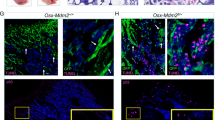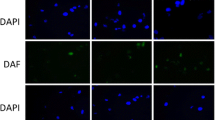Abstract
The gadd45 family of gene(s) is rapidly induced by genotoxic stress or by differentiation-inducing cytokines. Using bone marrow (BM) from gadd45a−/−, gadd45b−/− and wild-type (wt) mice, we investigated their role in stress responses of myeloid cells to acute stimulation with differentiating cytokines, myelotoxic agents and inflammatory substances. Bone marrow cells from gadd45a−/− and gadd45b−/− mice displayed compromised myeloid differentiation and higher apoptosis in vitro, following acute stimulation with a variety of differentiating cytokines. Intriguingly, gadd45a−/− and gadd45b−/− colony forming units granulocyte/macrophage progenitors displayed prolonged proliferation capacity compared to wt controls upon re-plating in methylcellulose supplemented with interleukin-3. The recovery of the BM myeloid compartment following 5-Fluorouracil-induced myelo-ablation was much slower in gadd45a−/− and gadd45b−/− mice compared to wt controls. Furthermore, the response of myeloid cells to inflammatory stress, inflicted via intraperitoneal administration of sodium caseinate was impaired in gadd45a−/− and gadd45b−/− mice compared to age-matched wt mice, as indicated by lower percentage of Gr-1-positive cells in the BM and lower number of myeloid cells in peritoneal exudates. Overall, these data indicate that both gadd45a and gadd45b play a role in modulating physiological stress responses of myeloid cells to acute stimulation with differentiating cytokines, myelo-ablation and inflammation. These findings should aid in understanding the response of normal and malignant hematopoietic cells to physiological and chemical stressors including anticancer agents.






Similar content being viewed by others
References
Abdollahi A, Lord KA, Hoffman-Liebermann B, Liebermann DA . (1991). Oncogene 6: 165–167.
Amanullah A, Azam N, Balliet A, Hollander C, Hoffman B, Fornace Jr A et al. (2003). Nature 424: 741–742.
Asada M, Yamada T, Ichijo H, Delia D, Miyazono K, Fukumuro K et al. (1999). EMBO J 18: 1223–1234.
Azam N, Vairapandi M, Zhang W, Hoffman B, Liebermann DA, Azam N et al. (2001). J Biol Chem 276: 2766–2774.
Beadling C, Johnson KW, Smith KA . (1993). Proc Natl Acad Sci USA 90: 2719–2723.
Cheng T, Rodrigues N, Shen H, Yang Y, Dombkowski D, Sykes M et al. (2000). Science 287: 1804–1808.
Daems WT, Koerten HK . (1978). Cell Tissue Res 190: 47–60.
De Smaele E, Zazzeroni F, Papa S, Nguyen DU, Jin R, Jones J et al. (2001). Nature 414: 308–313.
Gupta M, Gupta SK, Balliet AG, Hollander MC, Fornace AJ, Hoffman B et al. (2005). Oncogene 24: 7170–7179.
Harkin DP, Bean JM, Miklos D, Song YH, Truong VB, Englert C et al. (1999). Cell 97: 575–586.
Hestdal K, Ruscetti FW, Ihle JN, Jacobsen SEW, Dubois CM, Kopp WC et al. (1991). J Immunol 147: 22–28.
Hildesheim J, Bulavin DV, Anver MR, Alvord WG, Hollander MC, Vardanian L et al. (2002). Cancer Res 62: 7305–7315.
Hoffmeyer A, Piekorz R, Moriggl R, Ihle JN . (2001). Mol Cell Biol 21: 3137–3143.
Hollander MC, Sheikh MS, Bulavin DV, Lundgren K, Augeri-Henmueller L, Shehee R et al. (1999). Nat Genet 23: 176–184.
Kastan MB, Zhan Q, El-Deiry WS, Carrier F, Jacks T, Walsh WV et al. (1992). Cell 71: 587–597.
Lang R, Patel D, Morris JJ, Rutschman RL, Murray PJ . (2002). J Immunol 169: 2253–2263.
Liebermann DA, Hoffman B . (1994). Curr Opin Hematol 1: 24–32.
Liebermann DA, Hoffman B . (2003). Blood Cells Mol Dis 31: 213–228.
Liebermann DA, Hoffman-Liebermann B . (1989). Oncogene 4: 583–592.
Lu B, Ferrandino AF, Flavell RA . (2004). Nat Immunol 5: 38–44.
Lu B, Yu H, Chow C, Li B, Zheng W, Davis RJ et al. (2001). Immunity 14: 583–590.
Marone M, Bonanno G, Rutella S, Leone G, Scambia G, Pierelli L . (2002). Leukemia Lymphoma 43: 51–57.
Metcalf D . (1989). Nature 339: 27–30.
Moriggl R, Topham DJ, Teglund S, Sexl V, McKay C, Wang D et al. (1999). Immunity 10: 249–259.
Nakahata T, Ogawa M . (1982). Proc Natl Acad Sci USA 79: 3843.
Nguyen HQ, Hoffman-Liebermann B, Liebermann DA . (1993). Cell 72: 197–209.
Papa S, Zazzeroni F, Bubici C, Jayawardena S, Alvarez K, Matsuda S et al. (2004). Nat Cell Biol 6: 146–153.
Platanias LC . (2003). Blood 101: 4467–4479.
Randall TD, Weissman IL . (1997). Blood 89: 3596–3606.
Richman CM, Weiner RS, Yankee RA . (1976). Blood 47: 1031–1039.
Selvakumaran M, Lin HK, Tjin Tham Sjin R, Reed J, Liebermann DA, Hoffman B . (1994). Mol Cell Biol 14: 2352–2360.
Smith ML, Chen IT, Zhan Q, Bae I, Chen CY, Gilmer TM et al. (1994). Science 266: 1376–1380.
Smith ML, Kontny HU, Zhan Q, Sreenath A, O'Connor PM, Fornance Jr AJ . (1996). Oncogene 13: 2255–2263.
Takekawa M, Saito H . (1998). Cell 95: 521–530.
Takekawa M, Tatebayashi K, Itoh F, Adachi M, Imai K, Saito H . (2002). EMBO J 21: 6473–6482.
Taylor PR, Brown GD, Geldhof AB, Martinex-Pomores L, Gordon S . (2003). Eur J Immunol 33: 2090–2097.
Teglund S, McKay C, Schuetz E, van Deursen JM, Stravopodis D, Wang D et al. (1998). Cell 93: 841–850.
Vairapandi M, Azam N, Balliet AG, Hoffman B, Liebermann DA . (2000). J Biol Chem 275: 16810–16819.
Vairapandi M, Balliet AG, Fornance Jr AJ, Hoffman B, Liebermann DA . (1996). Oncogene 12: 2579–2594.
Vairapandi M, Balliet AG, Hoffman B, Liebermann DA . (2002). J Cell Physiol 192: 327–338.
Wang XW, Zhan Q, Coursen JD, Khan MA, Kontny HU, Yu L et al. (1999). Proc Natl Acad Sci USA 96: 3706–3711.
Yang J, Zhu H, Murphy TL, Ouyang W, Murphy KM . (2001). Nat Immunol 2: 157–164.
Yoo J, Ghiassi M, Jirmanova L, Balliet AG, Hoffman B, Fornace Jr AJ et al. (2003). J Biol Chem 278: 43001–43007.
Zazzeroni F, Papa S, Algeciras-Schimnich A, Alvarez K, Melis T, Bubici C et al. (2003). Blood 102: 3270–3279.
Zhan Q, Antinore MJ, Wang XW, Carrier F, Smith ML, Harris CC et al. (1999). Oncogene 18: 2892–2900.
Zhan Q, Lord KA, Alamo Jr I, Hollander MC, Carrier F, Ron D et al. (1994). Mol Cell Biol 14: 2361–2371.
Zhang W, Bae I, Krishnaraju K, Azam N, Fan W, Smith K et al. (1999). Oncogene 18: 4899–4907.
Acknowledgements
We thank Dr Albert Fornace Jr for the Gadd45a−/− mice. This work was supported by RO1 HL70530-03 (DL).
Author information
Authors and Affiliations
Corresponding author
Additional information
Supplementary Information accompanies the paper on the Oncogene website (http://www.nature.com/onc)
Supplementary information
Rights and permissions
About this article
Cite this article
Gupta, S., Gupta, M., Hoffman, B. et al. Hematopoietic cells from gadd45a-deficient and gadd45b-deficient mice exhibit impaired stress responses to acute stimulation with cytokines, myeloablation and inflammation. Oncogene 25, 5537–5546 (2006). https://doi.org/10.1038/sj.onc.1209555
Received:
Revised:
Accepted:
Published:
Issue Date:
DOI: https://doi.org/10.1038/sj.onc.1209555
- Springer Nature Limited
Keywords
This article is cited by
-
PPARγ regulates the expression of genes involved in the DNA damage response in an inflamed endometrium
Scientific Reports (2022)
-
Changes in the liver transcriptome of farmed Atlantic salmon (Salmo salar) fed experimental diets based on terrestrial alternatives to fish meal and fish oil
BMC Genomics (2018)
-
RETRACTED ARTICLE: MiR-362-5p promotes the malignancy of chronic myelocytic leukaemia via down-regulation of GADD45α
Molecular Cancer (2015)
-
Phosphorylation of Atg5 by the Gadd45β–MEKK4-p38 pathway inhibits autophagy
Cell Death & Differentiation (2013)




